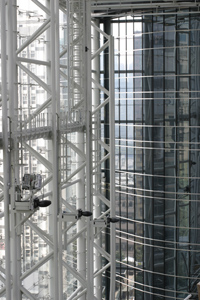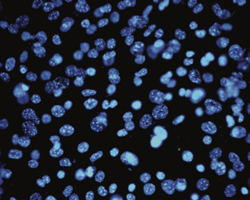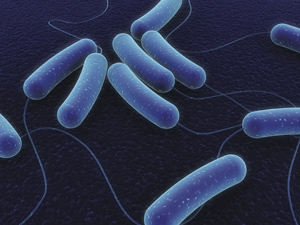Biological Complexity
 The biological research of the last few decades has revealed the remarkable complexity of living things and, in particular, of the living cell. For example, although the 50 trillion (that’s fifty thousand billion or 50,000,000,000,000) or so cells which make up the human body are too small to be seen except with a microscope, each one is a veritable nano-technological factory on a grand scale. Far from being the simple blob of protoplasm envisaged by Darwin and his contemporaries, modern biology has revealed a cellular world as complex as a galaxy of stars or a modern mega-city. The complexity and variety of the living cell is actually one of the best kept secrets of the modern world.
The biological research of the last few decades has revealed the remarkable complexity of living things and, in particular, of the living cell. For example, although the 50 trillion (that’s fifty thousand billion or 50,000,000,000,000) or so cells which make up the human body are too small to be seen except with a microscope, each one is a veritable nano-technological factory on a grand scale. Far from being the simple blob of protoplasm envisaged by Darwin and his contemporaries, modern biology has revealed a cellular world as complex as a galaxy of stars or a modern mega-city. The complexity and variety of the living cell is actually one of the best kept secrets of the modern world.
Intuitively, complexity on this scale suggests deliberate design. But there is a more secure basis for that conclusion than intuition. William Dembski, a mathematician and philosopher of science, has studied the complex biochemistry of living systems from the perspective of probability theory. He has demonstrated mathematically that their complexity cannot be explained by chance processes or existing natural laws. He describes the complexity of the cell as ‘specified’, meaning that it requires the input of specific information to assemble and operate such systems.
A simple analogy clarifies the nature of ‘specific complexity’. A safety razor is a useful, and to many people, an indispensable tool. It is clearly designed and, in its own way, complex. The plastic or metal handle is shaped for ease of handling; its head can follow the contours of the skin; and its single or multiple blades protrude to just the right height for effective shaving and to avoid cutting the skin. Although razors come in various shapes sizes and colours, the basic design is clear. You would never even consider that it was not deliberately designed. It has obviously been constructed according to a previously specified plan.
 But what is also clear is that a safety razor is made for a specific purpose. It is not for stripping wallpaper or for removing stains from the carpet. It is specifically designed to remove hair from skin. In that sense it has ‘specified complexity’ relating to its function. The analogy illustrates that ‘specified complexity’ relates to both assembly and function.
But what is also clear is that a safety razor is made for a specific purpose. It is not for stripping wallpaper or for removing stains from the carpet. It is specifically designed to remove hair from skin. In that sense it has ‘specified complexity’ relating to its function. The analogy illustrates that ‘specified complexity’ relates to both assembly and function.
A further analogy comes from a fax machine. When a fax reaches my office, I do not think that it has been generated by electrical noise, but by someone perhaps many miles away. The message I take out of my machine is not just a random collection of bits of paper and blobs of ink, but an intelligible message. Although the paper I hold in my hand has no physical connection with the paper that was inserted in the fax machine at the sending office, it is ‘specified’ by the contents of the original document. And the information in both originated in the mind of the individual who composed the message. So a fax message which is received in my office has a complexity which is specified by a distant mind and expressed in language which has been transmitted to me.
This indeed is the nature of the complexity found in living systems. For example, the mechanisms in the living cell for producing proteins from amino acids, the essential
basis of all life, are colossally complex. They depend on enzymes, which act like chemical ushers which select and modify the individual chemicals which are required in the process. They also involve tiny structures like ribosomes which act like extrusion mechanisms for the newly formed proteins. The operation of the system for protein synthesis is not only complex, but it is also very specific, generating in different parts of the cell and of the body each one of the thousands of proteins in the exact configurations and quantities required to sustain life. And this is only one example of specified complexity in living systems. There are thousands of them.
Michael Behe, a prominent American biochemist, has taken the idea one stage further. He has concluded that the specified complexity of certain living systems suggest that they are also ‘irreducibly complex’. By that he means that each component is required to make the system operate and the removal of any one of them makes it impossible to function.
 Many structures we encounter in daily life are irreducibly complex. A mousetrap is a good example of an irreducibly complex system. It has 5 parts and each one is necessary if the device is to catch a mouse. If any one of the parts is removed, the trap will not work.
Many structures we encounter in daily life are irreducibly complex. A mousetrap is a good example of an irreducibly complex system. It has 5 parts and each one is necessary if the device is to catch a mouse. If any one of the parts is removed, the trap will not work.
Behe has used the term to describe the function of the bacterial flagellum, a tail-like structure present in many bacteria. It is, in effect, a biological outboard motor with around 30 parts. It can rotate at speeds of up to 100,000 rpm and has protein parts that act as stators, rotors, O-rings and drive shafts. Behe has noted that the removal of any part of the bacterial flagellum renders it useless. It is, he argues, irreducibly complex.
This points not only to the existence of deliberate design, but also raises a critical problem for accepted evolutionary explanations of its origin. In order to develop a system like the bacterial flagellum, evolutionary theory requires that each intermediate stage, and there would have to be scores of them, has to be fully functional and beneficial to the organism. It is difficult to visualise how a system that requires each one of its 30 parts to be fully operational can gradually evolve by random mutation and natural selection, while maintaining full functionality at each stage, even if the intermediate stages are something other than flagellums.
And again, the bacterial flagellum is only one of hundreds of systems in living things which can be described as irreducibly complex.
Dr Alastair Noble
Director of the Centre for Intelligent Design UK
May 2016
Image credits:
Thumbnail - This work has been released into the public domain by its author, LadyofHats.
Article images - licence to use images held by C4ID